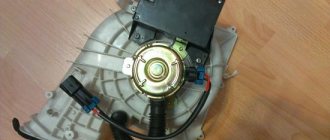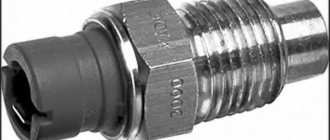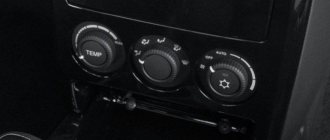When winter comes, a properly functioning stove is very important to VAZ-2114 owners. I want to get into a warm car and go. But this is not always possible. After driving in the spring and summer, the driver discovers that when the heater is turned on for heating, the stove makes a whistle. This unpleasant noise comes from the fan. Sometimes the whistling disappears immediately after the heating starts, and in other cases it does not stop for a long time. This brings discomfort and irritates at least the driver and his passengers.
Finding the causes and eliminating the whistling of the VAZ-2114 stove
When winter comes, a properly functioning stove is very important to VAZ-2114 owners. I want to get into a warm car and go. But this is not always possible. After driving in the spring and summer, the driver discovers that when the heater is turned on for heating, the stove makes a whistle. This unpleasant noise comes from the fan. Sometimes the whistling disappears immediately after the heating starts, and in other cases it does not stop for a long time. This brings discomfort and irritates at least the driver and his passengers.
How does the heating system work?
The VAZ-2114 stove is noisy due to malfunctions in the heating system. When the heater is in normal condition, the driver receives only heat and normal noise levels. The stove always makes certain sounds, but normally they do not cause problems.
In the cabin, under the dashboard, there is a heating radiator. It is blown with air using a fan. The VAZ-2114 is equipped with a fairly powerful fan at several speeds. The higher the driver selects the fan speed, the more heat enters the cabin.
When the heater is working well, the most noticeable sound made by the stove is the flow of warm air. But when problems appear, you need to try to quickly find the causes and get rid of them.
What is a heater fan
The VAZ-2114 stove fan is a conventional DC electric motor, powered by the vehicle’s on-board power supply. The air flow is created by the rotation of a cylindrical impeller mounted on the armature shaft.
The fan is controlled using a special switch located on the control panel. It has four positions corresponding to its operating modes: “OFF” mode and three speeds. The higher the speed of rotation of the impeller, the stronger the flow of air supplied to the cabin.
Causes of malfunctions
If the heater starts to make noise or hum, this should be considered a breakdown or malfunction. Extraneous sounds are signs of failure:
- if there is no airflow or noise appears, the potential cause will be the fan;
- if after the noise appears the cause is not found and eliminated, the heater may suddenly stop working and warm up the interior, which indicates a breakdown of the heater motor;
- The stove may also whistle due to brushes, bearings or bushings that have broken.
When the heater motor of a VAZ-2114 car whistles, this indicates a problem in the elements of the heating system. Therefore, it is best to disassemble the structure and find the cause of the extraneous sounds.
Important! During long-term operation of a VAZ-2114 car, the heater may fail due to insufficient care and lack of preventative maintenance of the system. Bearings, brushes and bushings exhaust their service life. Therefore, the only solution is to completely replace them.
Try to react quickly to the appearance of a whistle. At first it can only cause auditory discomfort for the driver and passengers. A whistle is a direct signal that the heating system is not operating normally.
Let's sum it up
As you can see, the standard heater fan on domestic VAZ models can be a real problem, since the engine is often noisy and humming. Of course, this affects the comfort when operating the vehicle. It also happens that the motor of the stove 2114 and other similar models completely fails. In this case, the stove does not work, but the interior heater system itself is fully operational.
In such a situation, the only correct solution would be to replace the stove fan with a VAZ-2114. Taking into account the fact that such a replacement is not difficult, you can fix the problem yourself in a regular garage. This means that there is no need to contact the service, since all work can be completed independently in 1-2 hours.
Finally, we note that when performing such work related to the ventilation and heating system of the vehicle interior, it is important to achieve maximum density when connecting individual elements. This will avoid output losses and obtain good airflow quality and powerful air flow even at low stove fan speeds.
For this reason, it is necessary to adhere to the above recommendations regarding disassembly and reassembly of the element discussed in this article.
Repair
It is better to start repairing a heater with simple techniques that can help return the stove to normal and quiet operation without replacing system elements. To do this, remove the device, remove all debris and add fresh lubricant. In approximately 50–70% of cases, such measures are sufficient. Let's look at the stages of repairs designed to eliminate the whistle of the stove on a VAZ-2114.
Important! The stove is connected to the electrical network of the VAZ-2114 car. Therefore, before starting work, do not forget to turn off the power to the car by removing the negative terminal from the battery.
- Turn off the power to your vehicle to protect yourself. This will prevent short circuits.
- Remove the heater fan. This is not that difficult to do, but it will take some time.
- Another option is to free up access to the fan without completely dismantling it.
- If there is dirt or stuck debris near the fan, then all this must be removed. Often it was a leaf from a tree that got into the system in the fall that caused the heater to whistle on a VAZ-2114.
- Structurally, the fan is presented as an electric motor with a plastic impeller on the shaft. It is she who blows on the heater radiator.
- A common reason for the heater whistling on the VAZ-2114 is the electric motor. To be more precise, in its components. Bearings and bushings rotate, so disruption of this rotation can cause a whistle. The reason is dirt, wear and lack of quality lubrication.
- If dirt is found in the fan, it must be removed. It is easy to determine the need for cleaning. Grasp the impeller with your fingers and rotate the heater motor shaft. If rotation is difficult, clean the housing, remove all dirt and lubricate the moving parts with lubricant. In this case, WD-40 works well.
- If you cannot turn the impeller by hand, this indicates a problem with the shaft bearings. There is no point in repairing them. It's better to change it right away. But you need to disassemble the electric motor of the stove and evaluate the condition of the bearings. VAZ-2114 car owners are advised to simply change the electric motor assembly so as not to do unnecessary work. But if the budget is very limited, you will have to disassemble the structure and change only the bearings.
If you managed to do everything correctly, then the whistle, noise or hum will go away. It cannot be said that the VAZ-2114 has a bad stove. You just need to keep an eye on it, engage in timely prevention and respond to signals about its problems.
Be sure to share your opinion about the heating system of the VAZ-2114 and tell us about the problems with the stove that haunted you. It will be very interesting to discuss this issue together, share impressions and give useful advice.
Lada Vesta
Dismantling
First you need to remove the sedan's heater fan. It itself is located on the right side of the dashboard, in the housing of the heating system unit.
First you need to remove the negative terminal from the battery, and then begin disassembling the glove box.
Removing the glove compartment
To remove the glove box on a Vesta, you must first open it and then release the latches that hold the top edge of the lid. When this is done, all that remains is to pull the cover towards you, and the resistance of the 3 fasteners will be overcome. Eventually the lid will snap off.
Vesta glove compartment attachment points
Next, you will need to remove the ceiling light, otherwise you will not be able to remove the glove compartment. The lampshade itself is held in place by a spring-type retainer.
To remove it, you need to insert a knife or thin screwdriver into the groove from the front side, then carefully press and remove the lampshade. In the end, all that remains is to disconnect the plug. When the lampshade is removed, it is necessary to unscrew the 5 mounting screws that secure the box to the dashboard - a Torx T20 sprocket is used for this
When the lampshade is removed, it is necessary to unscrew the 5 mounting screws that secure the box to the dashboard - a Torx T20 sprocket is used for this.
Removing the fan
The next step in eliminating Lada Vesta heater fan noise on your own is to dismantle the unit itself.
When the glove box is removed, you need to look under the dashboard, where the fan will be visible. First of all, you need to disconnect the plug from it. Next, turn the fan counterclockwise, first pressing the latch.
The process is clearly shown in the video.
Getting rid of noise
After removing the unit, it is clear that as the vehicle is used, a layer of dust has formed on it, which can be 2-4 mm. In addition, various debris often gets stuck between the blades - these can be leaves, pieces of twigs, feathers, etc. All this during the rotation process creates a background noise - whistling, rustling, etc.
In addition, litter leads to an imbalance, which is especially noticeable when the fan is running at full power - all this creates vibration, and sometimes it is so obvious that the driver feels it on the steering wheel.
Dust on the blades
In this case, in order to eliminate the noise of the Lada Vesta heater fan, it needs to be thoroughly cleaned. And in order to inspect the unit for vibrations, it is recommended to power it from the battery. If noise still occurs, it is necessary to change the location of the balancing weights.
https://youtube.com/watch?v=OOaBR9izx5s
In addition, the body of the part can be covered with madeleine or another anti-creaking agent. This will reduce background noise. However, before gluing, the surface must be thoroughly wiped and then degreased with anti-silicone.
Everything is demonstrated in more detail in the video.
Assembly is carried out in reverse order.
The stove fan whistles (buzzes or crackles). Can it show up when it’s cold, what to do, how to remove it?
The car's heater is used very often; in winter we heat the interior, but in summer we cool it (cold air from the air conditioner). After a long mileage, and this is usually 80 - 100,000 kilometers, when the air blows, an irritable whistle begins to be heard, probably many have experienced this. After turning off the fan, the whistle disappears. It becomes clear that the stove is whistling, but not the stove itself - but the element for blowing it. What to do, how to fix it, because driving like this is really uncomfortable! There is a way out and in 70% of cases you can do everything yourself...
How to eliminate squeaking in the cabin
From time to time, so-called “crickets” take up residence in all cars.
This means that some parts become loose, fastenings become loose, and a creaking noise appears in the car interior when driving. Over time, the creaking in the cabin begins to irritate, and we all ask the question: “how to get rid of the creaking?” In this article we will look at the main causes of squeaking and will deal with eliminating crickets in the car interior. The main sources of crickets in the cabin can be: creaking wheels, creaking doors, creaking steering wheel when turning, creaking suspension, creaking when braking, creaking glass, creaking seats, creaking interior trim and much more.
Let's take a closer look at all the main causes of squeaking and try to fix the problem using available means.
How does airflow work?
The device is very simple - in the cabin, under the panel, there is a heater radiator (possibly an air conditioner nearby), on which a special powerful fan blows. As a rule, it has several blowing modes, usually divided from “1” to “4”; the more you turn on, the stronger the air flow will be. As it becomes clear, in winter the stove radiator is used to heat the interior, in winter the air conditioner radiator is used for cooling.
On new foreign cars it does not make noise (in the first and second positions it is practically inaudible); more precisely, a strong flow of air can be heard, but there are no third-party sounds. This indicates that the fan is working properly and the entire system is working normally.
If you experience a whistling or crackling sound when you turn on the fan, it means that something is wrong here, you need to disassemble the panel and remove the fan. Radiators have nothing to do with it.
Don't rush to dismantle
Having discovered that the fan of the VAZ-2114 heater does not work, you should not rush to dismantle and disassemble the heater. First you should check the electrical circuit of the device, namely:
- fuse;
- mode switch resistor;
- wiring
If the fan of the VAZ-2114 stove does not work, first of all we check the fuse. It is located in the main mounting block and is designated in the diagram as F-7 (30 A). We remove it from the mounting socket and “call” it with the tester. If necessary, we change it.
The next step is to diagnose the switch resistor. With the ignition on, turn the switch knob to the position corresponding to the third speed. If the fan starts working, change the resistor.
Checking the wiring involves measuring the voltage supplied to the device. Here you need to lift the hood, find the connector with the wires going to the fan, connect the voltmeter probes to them and take measurements, switching modes with the ignition on. There is voltage - the reason is in the electric motor itself, if not - it is better to contact an auto electrician to diagnose the wiring.
Basic faults
A whistle is already a malfunction - there are not many of them in this unit. You have to say “heater” - either it works or it doesn’t. If the stove does not blow at all, this means the electric motor is jammed or the brushes are worn out. If you were still skating with a bang, and then at one point it disappeared, and the heater stopped working, then it’s definitely an engine failure, most likely the problem is in the bearing or bushings.
However, a whistle does not mean that the electric motor is failing; it is possible that dirt has simply accumulated there (from a long time of use) and needs to be cleaned.
Therefore, in 70% of cases, lubrication really helps, but if you have been driving for a long time with noise, it is possible that the bearing is already worn out. Therefore, as soon as noise appears, crackling and so on, we disassemble the stove and clean it. What else I would like to note on our VAZs, especially on the “classics”, bushings were used instead of bearings; after they were worn out, they needed to be replaced, however, many craftsmen still install bearings on the VAZ heater - I think this is correct!
Brush wear and commutator destruction
The brushes supply electric current to the armature of the electric motor. They are made of graphite and are naturally subject to wear. If the electric motor operates in normal mode, they can last for 50-70 thousand kilometers. However, the influence of various negative factors reduces the service life of the latter several times.
Destruction of the commutator is most often a consequence of wear or distortion of the brushes. Restoring this element is quite problematic even for a specialist, therefore, if a similar problem is discovered, then replacing the stove fan for the VAZ-2114 will become inevitable.
Disassembly - cleaning the fan
As I already wrote above, in each car the removal of this device is done differently, but the essence always remains the same, we either have the fan completely removed or there is direct access to it so that the elements can be lubricated.
I WOULD LIKE TO CAUTION - before you remove the electric motor, disconnect the terminals from the car battery to avoid unnecessary unnecessary short circuits.
The fan is almost always designed the same way - it is an electric motor and at the top there is a cylindrical comb (blades) that pumps air. Here's a small example.
The whistle comes from the engine itself; it has one or two bearings that hold the rotation shaft. If the bearings fail or become clogged with (annual) dirt, strange sounds occur - whistling, crackling, buzzing, etc. There are two possible scenarios:
- Just cleaning . Diagnostics is simple, try turning the removed motor - if it turns difficult, sometimes even with familiar sounds, then vacuum the engine, lubricate the bearings and other rotating elements (can be done with any silicone grease, sometimes you can use WD-40), clean all the dirt from the shaft.
Usually this is enough in 70% of cases, the electric motor starts working quietly, easily, without unnecessary sounds. Enough for a very long time of silent operation.
- Repair and replacement of shaft bearings . Diagnostics - the shaft does not rotate at all. Here the matter is more complicated, you will need to disassemble the engine itself - “look inside it.” Due to prolonged incorrect operation, bearings can jam, they simply break, the balls “wedge” in them. Many people can now say - why bother, you just need to buy a new engine! Perhaps this is a fairer remark, but the cost of the heater fan (and as a rule it comes assembled) is not very small. For example, for an ordinary foreign car of class “C” it will vary from approximately 5,000 to 10,000 rubles, which is a lot! And if you have a car of a higher class, then prices rise geometrically. So replacing bearings is very justified; they cost pennies.
Lada 2115 second life › Logbook › Is the stove whistling? That way)))
Many people are faced with such a problem as a whistling stove. I encountered this myself at the end of autumn, the first thought was to buy a new motor, well, I think I’ll take it apart, see what’s going on and then decide. In the end, I took it apart, found the cause, and eliminated it; I’m still driving fine, no more whistling. I decided to share my method of dealing with stove whistling with you! I’ve had a stove motor assembly from a 2108 with a low torpedo lying around in my garage for a long time; it’s not much different, but the gist will be clear,
and so let's go... We halve it
Now we need to determine where the whistle is coming from: it can come from the bearings if they are dusty or run out of lubricant
In the case of this motor, it was the same - the whistle was coming from the lower bearing, which is difficult to access, well, it’s not scary, we take a tube with a tube and carefully spray it there...
We turn it and listen... why listen? the whistle disappeared)))) on my motor the whistle was due to a large amount of play in the shaft in the bearing, you can check for play this way: with one hand we grab the motor with the other hand on the fan, we hold the motor motionless and we try to move the fan back and forth parallel to the motor shaft...
The VAZ 2114 stove creaks
Guys, tell me, the stove creaked and started running on the VAZ2114, after some time it makes this noise, tell me, or is it easier to change the motor to it, otherwise right now - 30 I don’t want to drive without it
Yes, this is a disease on all 14k and only in cold weather, when there is no such warmth, nothing needs to be changed
Try turning on the cold air all the way, I had a fable yesterday that seems to have disappeared
My Kalina only whistles when the car is cold, when it’s warm everything is fine
The stove is worn out and that's it, I've been driving like this for now, in the first mode it also squeaks, but it's normal, there will be an opportunity, change it
Most likely the leaves got in. I also had a rustling noise there and then it stopped.
[id178351603|Zhenya], change it, change it, I changed it on the seven at my place and quickly wrote it to him. Yes, it came for 2 days, it creaked and died)))) it’s -6 degrees in winter in January, how come everyone is in shock)))))
I warn you, the stove is clean, I have a filter on the casing and no leaves will get in
[id218226711|Alexander], tomorrow we’ll have to change the head, otherwise we have 30 and don’t want the motor to grunt in such cold weather
I hit the spot
[id178351603|Zhenya], I recently changed it for a friend, he started to crackle, then buzzed and then did pffffffff and that’s it))))))) he doesn’t have long to change
I have this kind of bullshit often, but it’s nothing special, just leaves from the trees getting there.
It’s unlikely to go away on its own (unless, of course, it’s a dried out sheet or some other foreign object, then you can remove the cover under the hood and take a look), but in general it’s most likely that the grease has dried out or the bearing has worn out.
Maybe there was trash. For example leaves
I think it's time to change it
change the motor soon he will tell you bye.
At the MOST unexpected moment it will fly on the highway, for example, you'll gasp later
Repair and maintenance of the stove on the Lada Priora
Heater control panel on Priora
The air conditioning system may stop blowing for various reasons. If the heater blows cold air, and the car is without air conditioning, the driver will have to disassemble and replace some elements. This could be a malfunctioning control regulator, fan, heater valve, or other heating system component. In any case, first, let's understand the principle of operation.
The warm air flow is forced onto the device's radiator thanks to the fan. The speed of the latter varies depending on the temperature inside the car. The ratio of warm and cold air flows is regulated thanks to the valve.
The air flow enters directly into the car interior through a filter element designed to clean the air.
The Priora heater control unit is the main structural part; it is its regulator that is controlled by the driver. The stove control unit, by adjusting and analyzing all the necessary parameters, adjusts the stove motor so that it regulates the speed of the fan, as well as the position of the air damper.
Heating device radiator
Main aspects of repair
If the fan does not work or the stove generally stops working, then you need to understand that the repair process is a rather labor-intensive procedure. Before you remove the heater radiator on a Priora or how to remove the fan, you need to do diagnostics. First, the functionality of the thermostat is checked. If the lines connected to the device are warm, then the part is working.
If the fan does not work, first of all you need to check its contacts. Replacing the stove fan does not always solve the problem, especially if it involves oxidation of the contacts.
Sometimes simply cleaning the connector from the device is enough to solve the problem. You can always remove the heater fan, but the heater fan does not fail very often.
In addition, fuse F9 is responsible for the operation of the electrical components of the heating system, so if problems occur, it should also be checked and replaced if necessary.
If the fuse often fails, there is no need to buy a more powerful part - first of all, you need to check the electrical circuit using a multimeter.
The on-board network may be overloaded due to a short circuit (video author - Alexey Kalachev).
Allegedly, by removing consumables from the expansion tank to a minimum, the device will release heat more quickly. We would not recommend doing this as it does not solve the problem.
But if you leave the antifreeze level in the tank at a minimum, you need to check it regularly.
Sometimes the stove does not heat due to a breakdown of the valve designed to regulate cold and warm air flows. If the air flow is very weak, you need to check. What is the condition of the filter being used?
In any case, the bearing device needs to be replaced, since over time it can simply jam the fan, and this, you see, is much more serious than just noise in the cabin.
Sorry, there are no surveys available at this time.
Instructions for replacing the stove radiator
If you need to change a heater resistor or heater radiator, it would be better to dismantle the system in any case.
To replace the device, follow these steps:
- The heating device itself is fixed with four or five nuts, depending on the configuration and year of manufacture of the car. There is nothing complicated about this, these nuts need to be unscrewed.
- The next step is the most difficult, you need to dismantle the system. The heater is removed from the engine compartment at a certain angle. It is advisable to have someone help you at this stage, since removing the device yourself can be problematic.
- When the device is removed, you will need to unscrew the three screws that directly secure the radiator itself.
- The element is simply removed from its installation location and replaced with a new one. Further assembly steps are carried out in reverse order.
1. Remove the stove itself from the car.2. Remove the radiator and replace with a new one.
cold air in the stove!
Hi all. I had the same problem with a VAZ 2115. I drove it, everything was fine, even the heat, I had to undress. but one morning on the way to work I noticed that my feet began to freeze. I blew my hand, and there was cold “boiling water” from the street! No matter what I did, it was no worse than my comrade. Now I’m thinking about changing the heater tap. You can see the plates are sinking there. Also, replace the expansion tank cap. And when replacing the faucet, you need to look at the pipes that go to the stove, there may be delamination and a piece will block the flow of coolant. If you have any suggestions and advice, I will be happy to listen! PS I had a nine before, there were no such problems, I had antifreeze, and a thermostat with a tap and pump!
edited by Leshyj: 20:27 03/11/12
| VlAdS |
| Duke |
| Ryazan (Dmitry) |
| Life values and hobbies: Home - Family - Children - Dacha |
| Driving experience since: 1999 |
Install a bearing fan
I encountered the same problem on classic. I decided to replace the standard fan motor with a bearing motor. They look exactly the same, but the design is different. Perhaps you have the same problem, and the lack of squeaking on the nine is explained by the fact that there is most likely a bearing motor already installed there.
The user about whom you requested information is not registered in the system.The user about whom you requested information is not registered in the system.
That's my problem
I'll try to explain, because... I'm not a technical person. Machine 2114, 2005. Just yesterday, warm air stopped flowing into the cabin. When driving, everything is fine, but as soon as you let off the gas and then coast, it starts to go cold or when it just rattles at idle, the result is the same. So - what could it be? Yes, and even in the cabin, there is a barely audible murmur, like a stream, in the area of the heater radiator. This is the first time I’ve heard this air in 3 years. In short, today the car was being repaired all day. We changed the pump, antifreeze, blew out the stove, tightened the faucet cable. And the result is the same. Any thoughts?
Maestrog. Kemerovo (Valery)| Car model: 31519 |
What's the temperature outside? Is the engine insulated? On our cars, this is not superfluous in winter. Regarding the coasting and idle. In cold weather, with low engine load, the car cools down quite quickly. In Sivka, my radiator is sealed up tightly (-37 during the day), but at idle the stove still takes away heat so much that the engine cools down. And when coasting, in addition to everything, the antifreeze in the radiator has a low flow rate and cools down even faster.
By the way, there is no thermostat on your list. Has he been checked?
The user about whom you requested information is not registered in the system.The user about whom you requested information is not registered in the system.Viscount. Moscow (Alexey)
| Car model: RAV4 |
| Life values and hobbies: Auto - Moto |
| as well as: Computers - Internet |
| and also: Home - Family - Children - Dacha |
| Driving experience since: 1998 |
Thanks Don't like it
Roman22 Oct 24, 2008
But I noticed that the nature of the sound emitted at 10x and 15x is different: at 10x the impression is that the flow speed is very high and that the wind is howling, but at 15x, on the contrary, in my opinion, the problem is in the mechanisms, the motor is probably or indeed the aerodynamics of the impeller have not been worked out. Still, I’m wondering what kind of engine can be stuffed in there to make it run quieter. Even Roman22 doesn’t write.
In my opinion, any from the Japanese is possible, they have them in everyone’s cabin and are designed for low noise, but high speed. The alterations affected only the body, the so-called snail, the motor that I got was more expensive, a hacksaw, a file, a couple of tubes of super glue, better than gel, a lot of rants about what AvtoVAZ engineers came up with, at work I managed to deal with smoke breaks in 3 hours, left my impeller because from the Ino it was larger (it fit along the shaft without problems), but it seems like they are there with impellers like ours.
It’s hard for me to say why I got it, the one who gave it said from the crown, the guy wanted to install it in a mask, but sold the car in the end, as he explained to me, you stupidly take what’s yours and go to the showdown, where they take you to a warehouse and choose what’s more The idea suited him, so he chose it for himself, and in the end it suited me too.
Here's a photo, just in case I took it at home, but there's no actual remodeling process...











